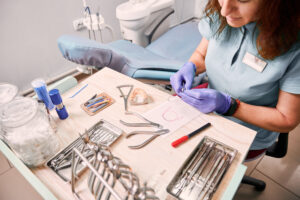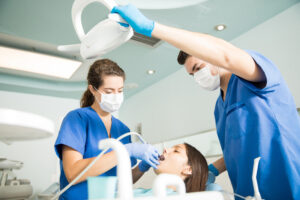The Impact of Teledentistry on Modern Dental Practice
In recent years, dentistry has seen an incredible shift, and one of the most revolutionary developments has been the emergence of teledentistry. Dramatic technological advancements, enhanced due to the recent global pandemic, have transformed the delivery of dental services as well as how dental professionals approach their careers via teledentistry.
In this blog, we will explore in depth what teledentistry is, how it reshaping the future of dental careers, the pros and cons of it, and what it means for dentists, hygienists, dental assistants, and dental organizations.
What is Teledentistry?
Teledentistry utilizes digital communication technologies to deliver dental care, consultation, education, and treatment remotely. With tele dentistry, dental professionals can meet patients through video calls, mobile applications and several other digital platforms rather than physically meeting them in the clinics.
Teledentistry usually consists of:
– Live video conferencing (remote care)
– Store-and-forward imaging (sending X-rays and images for later review)
– Remote patient monitoring
– Mobile health apps
– Prescriptions and follow-ups are done online
Using technology to improve access in rural or underserved areas by using virtual consultations, remote monitoring and tele-dentistry are increasing access to dental care in an area where physical dental clinics may be limited.
The Rise of Teledentistry
Although teledentistry was a term already in the dental literature, the COVID-19 pandemic has cataputled the use of teledentistry for patients. Lockdowns, social isolation and restricted access to in-person care led dental professionals to adopt digital solutions.
Teledentistry is now a mainstream service. Despite restrictions easing up, several clinics are still doing remote dental consultations due to the convenience, efficiency, and cost savings they offer.
How Teledentistry is Impacting Dental Careers?
Teledentistry is reshaping the dental landscape in several ways. Let’s explore its impact on different dental roles:
1. Dentists
Dentists are now able to:
– Diagnose and prescribe treatment via virtual consultations.
– Conduct non-urgent cases online and reduce in-clinic footfall.
– Expand your reach to more patients in the remote regions.
– Expand flexibility in how you care for patients by providing hybrid (on + offline) care.
Virtual dentistry is based on the principle that health (and oral health) determinants are a spectrum between prevention and treatment. Also, they can now work with specialists remotely for second opinions or referrals.
2. Dental hygienists and assistants
Teledentistry has created new opportunities for hygienists and assistants, including:
– Online session for patient education.
– Assessments–before a patient arrives at Frontline
– Virtual remote support for dentists in consultation.
In certain states or countries, although hygienists can also provide preventive care through teledentistry, they are under the supervision of dentists, so they have an expanded scope of work.
3. Dental Technologists and Laboratory Professionals
The sharing of digital images and 3D scans over the internet allows lab technicians to gain quicker and more accurate information with which to manufacture prosthetics, crowns, or orthodontic devices. The whole process is simpler with digital messaging, resulting in speedier responses and fewer mistakes.
Benefits of Teledentistry for Professionals and Patients
For Dental Professionals
Lower overhead costs (fewer in-office appointments)
– Improved time management
– Access to a larger patient base
– Opportunities to work remotely
-Reduced risk of infection
For Patients
– Convenient access to care
– Reduced travel and waiting time
– Affordable consultation options
– Increased awareness and education
– Timely treatment advice
Challenges and Considerations
Although teledentistry has several advantages, it also poses some challenges:
1. Regulatory and License Problems
Even some states and countries have not established a teledentistry jurisprudence. Dental professionals must remain apprised of legal standards with respect to remote care.
2. Limited Scope for Procedures
Teledentistry is best for consultations, diagnostics and education, and it can’t replace in-person procedures like fillings, cleanings or surgeries.
3. Technology Barriers
Laws that may relate to both patients and practitioners include:
– Poor internet connection
– Lack of technical know-how
Watch to learn about security premium concerns for patient data.
4. Reimbursement Policies
Not all insurance providers cover teledentistry services, and reimbursement policies are still developing.
So, in summary, while there are challenges, there is also a very positive overall outlook as technology continues to advance, with so many more health services making the transition to digital.
Conclusion about Teledentistry
Teledentistry is more than a temporary trend oral care. It’s improving access to oral health services, offering greater convenience to patients, and creating new opportunities for dentists to advance their careers in more flexible and innovative ways.
With an ever-evolving technology, we can see teledentistry eventually become part of day-to-day dentistry. For those professionals ready to embrace change, it creates new opportunities.
Now is an ideal time for dental professionals or students to future-proof their careers by learning about teledentistry tools and platforms.
Learn your local telehealth laws
Educate your staff about virtual consultation protocols
Embed digital systems in your practice workflow
Discover new careers in dental technology and digital health
Teledentistry is a flexible, forward-thinking path, whether you want to add to your practice or take your career in a new direction. All set to discover teledentistry jobs or expand your remote dental practice? Allow us to introduce you to exceptional opportunities in contemporary dentistry.
FAQs About Teledentistry and Dental Careers
1. Does teledentistry make it possible for dentists to work exclusively from home?
Not entirely. Although a lot of procedural work as well as consultations and follow-ups can be performed remotely, hands-on work will almost always require being in the office/clinic.
2. Is special training required to provide teledentistry?
You don’t require an additional degree, but you might want training in:
– Virtual communication
– Patient management software
– Telehealth regulations and data privacy
3. How can teledentistry benefit my dental practice?
It will help you attract new patients, implement follow-ups, reduce no-shows, and offer more flexible scheduling through remote consultations; all of which will lead to a better patient experience and a well-organized clinic.
4. Does teledentistry mean just for general dentists?
No, Specialists such as orthodontists, periodontists, and oral surgeons are also able to use teledentistry for consultation, treatment planning, and post-op reviews.





